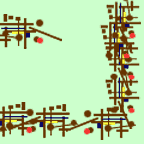
English 4292
Assignment One
Analysis of a Scene from Frankenstein
| Due Dates: | Requirements: |
| Working Draft—February 18th, 2015 Final Draft—February 25th, 2015 |
|
Objective
To construct a persuasive argument about the meaning of a scene in the film Frankenstein based on a careful analysis of literary and cinematic elements in the scene.
Procedure
Choose a scene from the film Frankenstein. A scene is a conversation or a unified sequence of events that all take place within a single location.
Take notes including specific details in the passage that explain its meaning and significance. Such details may include context, connections or deviations from literary source material, dialogue, setting, dramatic gestures, lighting, camera position, camera angle, sound effects and any other technique that the filmmaker has used in order to make her or his meaning clear to an audience. Focus on those details that are the most useful in explaining the meaning of the scene.
Formulate a thesis statement about the meaning and importance of the chosen scene. This thesis will undoubtedly change as you write your paper, but at least it will give you a place to start.
Write a draft of your argument about the scene in question. Refer to specific details in the scene—direct quotations of dialogue and/or, if you wish, stills from the scene—in order to support the points in your argument. You may also refer to other quotations in the larger work, as long as you use them to explain the meaning of the passage in question.
Bring a word-processed, correctly formatted draft of this paper to class on February 15th, 2015, for peer editing. Carefully identify the chosen scene in the opening paragraph.
After considering feedback you receive from peer editors and reconsidering your own argument, revise your paper. You may also sign up to meet with me to discuss a draft at this point.
Proofread your draft to remove spelling and grammatical errors.
Turn in the completed final draft along with a peer-edited working draft in class on February 25th, 2015.
Close Reading
Close reading means paying careful attention to details in a written work. Since you will be looking more closely at this scene than most viewers, your paper can offer perspectives on it that will interest your audience and challenge their expectations. In analyzing a brief passage, you may ask yourself the following questions:
What, literally, takes place in the scene?
Where in the film does the scene occur?
Who speaks in this scene, if anyone? To whom?
How is this scene different from any other scene in the film?
Is there anything distinctive about the arrangement of images in the scene? Are there clear parallels or contrasts implicit in the order of events or lines?
How does this scene resemble or deviate from an equivalent scene in the novel Frankenstein by Mary Shelley?
What will make this paper interesting to an audience consisting of your classmates, your teacher and yourself? You will want to tell them something new—that would not otherwise have occurred to them after viewing this scene.
Writing Tips
I have based the following writing tips on common difficulties that students encounter when writing papers for this class.
Develop an arguable and interesting thesis statement that applies directly to the scene (i. e., that you could not write about any other poem). A good thesis is arguable and interesting—a reasonable viewer could present a conflicting argument about the meaning of the scene.
Organize your argument around this thesis statement. Think of between two and four sub-points and structure your argument around them. Each subtopic should be in its own way arguable and contribute to the larger thesis statement.
MLA format means you should include a list of works cited at the end of your paper, even if it only includes one work. For example:
Frankenstein. 1931. Dir. James Whale. Perf. Colin Clive, Mae Clarke, John Boles, Boris Karloff. Universal, 1999. DVD.
Shelley, Mary. Frankenstein. 1818. New York: Oxford U. P., 1969. Print.
Some grammatical tips:
Avoid using the passive voice whenever it is possible to do so. When writing in the passive voice, you remove the subject from the sentence or at least de-emphasize it. This makes writing less engaging to most readers.
Example:
ACTIVE VOICE:
Walton befriends Frankenstein.(Note structure: subject/verb/object)
PASSIVE VOICE:
Frankenstein is befriended by Walton.(Structure: object/"to be" verb/past participle)
ACTIVE VOICE:
Walton befriended Frankenstein.PASSIVE VOICE:
Frankenstein was befriended by Walton.(Passive voice can exist in any verb tense.)
Avoid contractions when writing college papers. Replace they're with they are and replace don't with do not (these are just a few examples of the numerous possible contractions out there.
Italicization is the best way to signal that you are referring to a word itself and not to the thing that the word represents. You should also italicize titles of books and films (even in parenthetical references and lists of works cited) and foreign-language words like samizdat and status quo. In addition, titles of books (and magazines) should always be in italics. Titles of poems and short stories go in quotes—not in italics.
The word it's (with an apostrophe) is a contraction of it is. The word its (without an apostrophe) is the possessive of it. Its and whose both deviate from the above rule about possessives.
28 January 2015